Use of Fourier-Transform Infrared Spectroscopy for DNA Identification on Recycled PET Composite Substrate
Abstract
:1. Introduction
2. Materials and Methods
2.1. Materials
2.2. Recycled PET Composites’ Development and Characterization
2.2.1. Development
2.2.2. Hydrostatic Density and Determination of the Effects of Immersion in Water
2.2.3. Morphology and Thermal Features
2.3. DNA Identification on Recycled PET Composites
3. Results and Discussions
3.1. Recycled PET Composites’ Development and Characterization
3.2. DNA Identification on Recycled PET Composites
- -
- The appearance of the specific stretching vibrations for the OH and NH bonds of the amino acid at 3337 cm−1 in the M1_4_DNA sample, at 3335 cm−1 for M2_4_DNA, 3381 cm−1 for M6_4_DNA, 3346 cm−1 for M7_4_DNA, 3348 cm−1 for M11_4_DNA, and 3368 cm−1 for M12_4_DNA;
- -
- The overlapping of the 1634 cm−1 group assigned to the baFe vibrations with the deformation of the ester carbonyl bond of the PET compound for all samples: from 1713 to 1711 cm−1 in M1_4_DNA, 1712 to 1711 cm−1 in M2_4_DNA, 1714 to 1715 cm−1 in M7_4_DNA, and 1714 to 1712 cm−1 in the M11_4_DNA and M12_4_DNA samples;
- -
- The presence of a new peak at 1634/1639 cm−1 allocated to the same base region as observed in the case of the M1_4_DNA, M2_4_DNA, M7_4_DNA, M11_4_DNA, and M12_4_DNA samples, with a more intense signal, and weak in the case of the M6_4_DNA sample;
- -
- The C-O deoxyribose stretching observed at 1035 cm−1 in the spectrum of M7_4_DNA (absent in the bare M7_4 sample), at 1042 cm−1 in M1_4_DNA, at 1042 cm−1 in M11_4_DNA, and at 1040 cm−1 in the M12_4_DNA substrate, which is more intense and sharp when compared with the peaks in the same position for DNA-free samples.
3.3. Ethidium Bromide Fluorescence Boost upon Binding to the DNA Contaminants
4. Conclusions
5. Patents
Author Contributions
Funding
Institutional Review Board Statement
Informed Consent Statement
Data Availability Statement
Acknowledgments
Conflicts of Interest
References
- Koshti, R.; Mehta, L.; Samarth, N. Biological Recycling of Polyethylene Terephthalate: A Mini-Review. J. Polym. Environ. 2018, 26, 3520–3529. [Google Scholar] [CrossRef]
- Munoz, M.; Ortiz, D.; Nieto-Sandoval, J.; de Pedro, M.Z.; Casas, J.A. Adsorption of micropollutants onto realistic microplastics: Role of microplastic nature, size, age, and NOM fouling. Chemosphere 2021, 283, 131085. [Google Scholar] [CrossRef] [PubMed]
- Plastics Europe. Plastics—The Facts 2020 an Analysis of European Plastics Production, Demand and Waste Data. 2020. Available online: https://www.plasticseurope.org/en/resources/publications/4312-plastics-facts-2020 (accessed on 8 March 2022).
- MacArthur, D.E.; Waughray, D.; Stuchtey, R.M. The New Plastics Economy: Rethinking the Future of Plastics; World Economic Forum: Cologny, Switzerland, 2016. [Google Scholar]
- Gebre, S.H.; Sendeku, M.G.; Bahri, M. Recent Trends in the Pyrolysis of Non-Degradable Waste Plastics. ChemistryOpen 2021, 10, 1202–1226. [Google Scholar] [CrossRef]
- Maurya, A.; Bhattacharya, A.; Khare, S.K. Enzymatic Remediation of Polyethylene Terephthalate (PET)-Based Polymers for Effective Management of Plastic Wastes: An Overview. Front. Bioeng. Biotechnol. 2020, 8, 602325. [Google Scholar] [CrossRef] [PubMed]
- Geyer, R.; Jambeck, J.R.; Lavender Law, K. Production, use, and fate of all plastics ever made. Sci. Adv. 2017, 3, e1700782. [Google Scholar] [CrossRef] [Green Version]
- D’Ambrieres, W. Plastics recycling worldwide: Current overview and desirable changes. Field Actions Sci. Rep. 2019, 19, 12–21. [Google Scholar]
- Eurostat. EU Recycled 41% of Plastic Packaging Waste in 2019. Available online: https://ec.europa.eu/eurostat/web/products-eurostat-news/-/ddn-20211027-2 (accessed on 16 March 2022).
- Barthelemy, E.; Spyropoulos, D.; Milana, M.R.; Pfaff, K.; Gontard, N.; Lampi, E.; Castle, L. Safety evaluation of mechanical recycling processes used to produce polyethylene terephthalate (PET) intended for food contact applications. Food Addit. Contam. 2014, 31, 490–497. [Google Scholar] [CrossRef]
- Vollmer, I.; Jenks, M.J.F.; Roelands, C.P.; White, R.J.; van Harmelen, T.; de Wild, P.; van der Laan, G.R.; Meirer, F.; Keurentjes, J.T.F.; Weckhuysen, B.M. Beyond mechanical recycling: Giving new life to plastic waste. Angew. Chem. Int. Ed. 2020, 59, 15402–15423. [Google Scholar] [CrossRef] [Green Version]
- Raheem, A.B.; Noor, Z.Z.; Hassan, A.; Hamid, M.K.A.; Samsudin, S.A.; Sabeen, A.H. Current developments in chemical recycling of post-consumer polyethylene terephthalate wastes for new materials production: A review. J. Clean. Prod. 2019, 225, 1052–1064. [Google Scholar] [CrossRef]
- Silano, V.; Barat Baviera, J.M.; Bolognesi, C.; Chesson, A.; Cocconcelli, P.S.; Crebelli, R.; Gott, D.M.; Grob, K.; Mortensen, A.; Riviere, G.; et al. Safety assessment of the process RE-PET, based on EREMA Basic technology, used to recycle post-consumer PET into food contact materials. EFSA J. 2020, 18, 6049. [Google Scholar] [CrossRef]
- Franz, R.; Welle, F. Contamination Levels in Recollected PET Bottles from Non-Food Applications and their Impact on the Safety of Recycled PET for Food Contact. Molecules 2020, 25, 4998. [Google Scholar] [CrossRef] [PubMed]
- Welle, F. Decontamination efficiency of a new post-consumer polyethylene terephthalate (PET) recycling concept. Food Addit. Contam. 2008, 25, 123–131. [Google Scholar] [CrossRef] [Green Version]
- Mancini, S.D.; Schwartzman, J.A.S.; Rodriques Nogueira, A.; Kagohara, D.A.; Zanin, M. Additional steps in mechanical recycling of PET. J. Clean. Prod. 2010, 18, 92–100. [Google Scholar] [CrossRef]
- Hossain, S.; Mozumder, S.I. Post-consumer polyethylene terephthalate (PET) recycling in Bangladesh through optimization of hot washing parameters. ASRJETS 2018, 40, 62–76. [Google Scholar]
- Cabanes, A.; Fullana, A. New methods to remove volative organic compounds from post-comsumer plastic waste. Sci. Total Environ. 2021, 758, 144066. [Google Scholar] [CrossRef] [PubMed]
- Félix, J.S.; Alfaro, P.; Nerín, C. Pros and cons of analytical methods to quantify surrogate contaminants from the challenge test in recycled polyethylene terephthalate. Anal. Chim. Acta 2011, 687, 67–74. [Google Scholar] [CrossRef] [PubMed]
- Balan, V.; Mihai, C.-T.; Cojocaru, F.-D.; Uritu, C.-M.; Dodi, G.; Botezat, D.; Gardikiotis, I. Vibrational Spectroscopy Fingerprinting in Medicine: From Molecular to Clinical Practice. Materials 2019, 12, 2884. [Google Scholar] [CrossRef] [Green Version]
- ISO—International Organization for Standardization. Available online: https://www.iso.org/standard/55483.html (accessed on 11 March 2022).
- Mizera, A.; Manas, M.; Stoklasek, P. Effect of Temperature Ageing on Injection Molded High-Density Polyethylene Parts Modified by Accelerated Electrons. Materials 2022, 15, 742. [Google Scholar] [CrossRef]
- Gomiero, A.; Strafella, P.; Fabi, G. From Macroplastic to Microplastic Litter: Occurrence, Composition, Source Identification and Interaction with Aquatic Organisms. Experiences from the Adriatic Sea. In Plastics in the Environment; Gomiero, A., Ed.; IntechOpen: London, UK, 2019; pp. 1–20. [Google Scholar] [CrossRef]
- Schulz, M.; Schäfer, M.; Saalwächter, K.; Thurn-Albrecht, T. Competition between crystal growth and intracrystalline chain diffusion determines the lamellar thickness in semicrystalline polymers. Nat. Commun. 2022, 13, 119. [Google Scholar] [CrossRef]
- Glaser, J.A. Biological Degradation of Polymers in the Environment. In Plastics in the Environment; Gomiero, A., Ed.; IntechOpen: London, UK, 2019; pp. 73–94. [Google Scholar] [CrossRef] [Green Version]
- Rahman, K.S.; Islam, M.N.; Rahman, M.M.; Hannan, M.O.; Dungani, R.; Khalil, H.A. Flat-pressed wood plastic composites from sawdust and recycled polyethylene terephthalate (PET): Physical and mechanical properties. SpringerPlus 2013, 2, 629. [Google Scholar] [CrossRef] [Green Version]
- Li, Y.; Yang, J.; Yu, X.; Sun, X.; Chen, F.; Tang, Z.; Zhu, L.; Qin, G.; Chen, Q. Controlled Shape Deformation of Bilayer Film with Tough Adhesion between Nanocomposite Hydrogel and Polymer Substrate. J. Mater. Chem. B 2018, 6, 6629–6636. [Google Scholar] [CrossRef] [PubMed]
- Ziąbka, M.; Dziadek, M. Thermoplastic Polymers with Nanosilver Addition-Microstructural, Surface and Mechanical Evaluation during a 36-Month Deionized Water Incubation Period. Materials 2021, 14, 361. [Google Scholar] [CrossRef] [PubMed]
- Chen, R.S.; Ab Ghani, M.H.; Salleh, M.N.; Ahmad, S.; Gan, S. Influence of Blend Composition and Compatibilizer on Mechanical and Morphological Properties of Recycled HDPE/PET Blends. Mater. Sci. Appl. 2014, 5, 943–952. [Google Scholar] [CrossRef] [Green Version]
- Han, Y.; Han, L.; Yao, Y.; Li, Y.; Liu, X. Key factors in FTIR spectroscopic analysis of DNA: The sampling technique, pretreatment temperature and sample concentration. Anal. Methods 2018, 10, 2436–2443. [Google Scholar] [CrossRef]
- Pakbin, B.; Zolghadr, L.; Rafiei, S.; Brück, W.M.; Brück, T.B. FTIR differentiation based on genomic DNA for species identification of Shigella isolates from stool samples. Sci. Rep. 2022, 12, 2780. [Google Scholar] [CrossRef]
- Gomes Rios, T.; Larios, G.; Marangoni, B.; Oliveira, S.L.; Cena, C.; do Nascimento Ramos, C.A. FTIR spectroscopy with machine learning: A new approach to animal DNA polymorphism screening. Spectrochim. Acta A Mol. Biomol. Spectrosc. 2021, 261, 120036. [Google Scholar] [CrossRef] [PubMed]
- Banyay, M.; Sarkar, M.; Gräslund, A. A library of IR bands of nucleic acids in solution. Biophys. Chem. 2003, 104, 477–488. [Google Scholar] [CrossRef]
- Dos Santos Pereira, A.P.; Prado da Silva, M.H.; Pereira Lima Júnior, E.; Dos Santos Paula, A.; Tommasini, F.J. Processing and Characterization of PET Composites Reinforced With Geopolymer Concrete Waste. Mat. Res. 2017, 20. [Google Scholar] [CrossRef] [Green Version]
- Edge, M.; Wiles, R.; Allen, N.S.; McDonald, W.A.; Mottock, S.V. Characterization of the species responsible for yellowing in melt degraded aromatic polyesters-I: Yellowing of poly(ethylene terephthalate). Polym. Degrad. Stab. 1996, 53, 141–151. [Google Scholar] [CrossRef]
- Silverstein, R.M.; Webster, F.X. Spectrometric Identification of Organic Compounds; Wiley: New York, NY, USA, 1998. [Google Scholar]
- González-Gómez, M.A.; Belderbos, S.; Yañez-Vilar, S.; Piñeiro, Y.; Cleeren, F.; Bormans, G.; Deroose, C.M.; Gsell, W.; Himmelreich, U.; Rivas, J. Development of Superparamagnetic Nanoparticles Coated with Polyacrylic Acid and Aluminum Hydroxide as an Efficient Contrast Agent for Multimodal Imaging. Nanomaterials 2019, 9, 1626. [Google Scholar] [CrossRef] [Green Version]
- Tariq, A.; Afzal, A.; Rashid, I.A.; Fayzan, S.H.M. Study of thermal, morphological, barrier and viscoelastic properties of PP grafted with maleic anhydride (PP-g-MAH) and PET blends. J. Polym. Res. 2020, 27, 309. [Google Scholar] [CrossRef]
- Krehula, L.K.; Katančić, Z.; Ptiček Siročić, A.; Hrnjak-Murgić, Z. Weathering of High-Density Polyethylene-Wood Plastic Composites. J. Wood Chem. Technol. 2014, 34, 39–54. [Google Scholar] [CrossRef]
- Olmsted, J., III; Kearns, D.R. Mechanism of ethidium bromide fluorescence enhancement on binding to nucleic acids. Biochemistry 1977, 16, 3647–3654. [Google Scholar] [CrossRef] [PubMed]

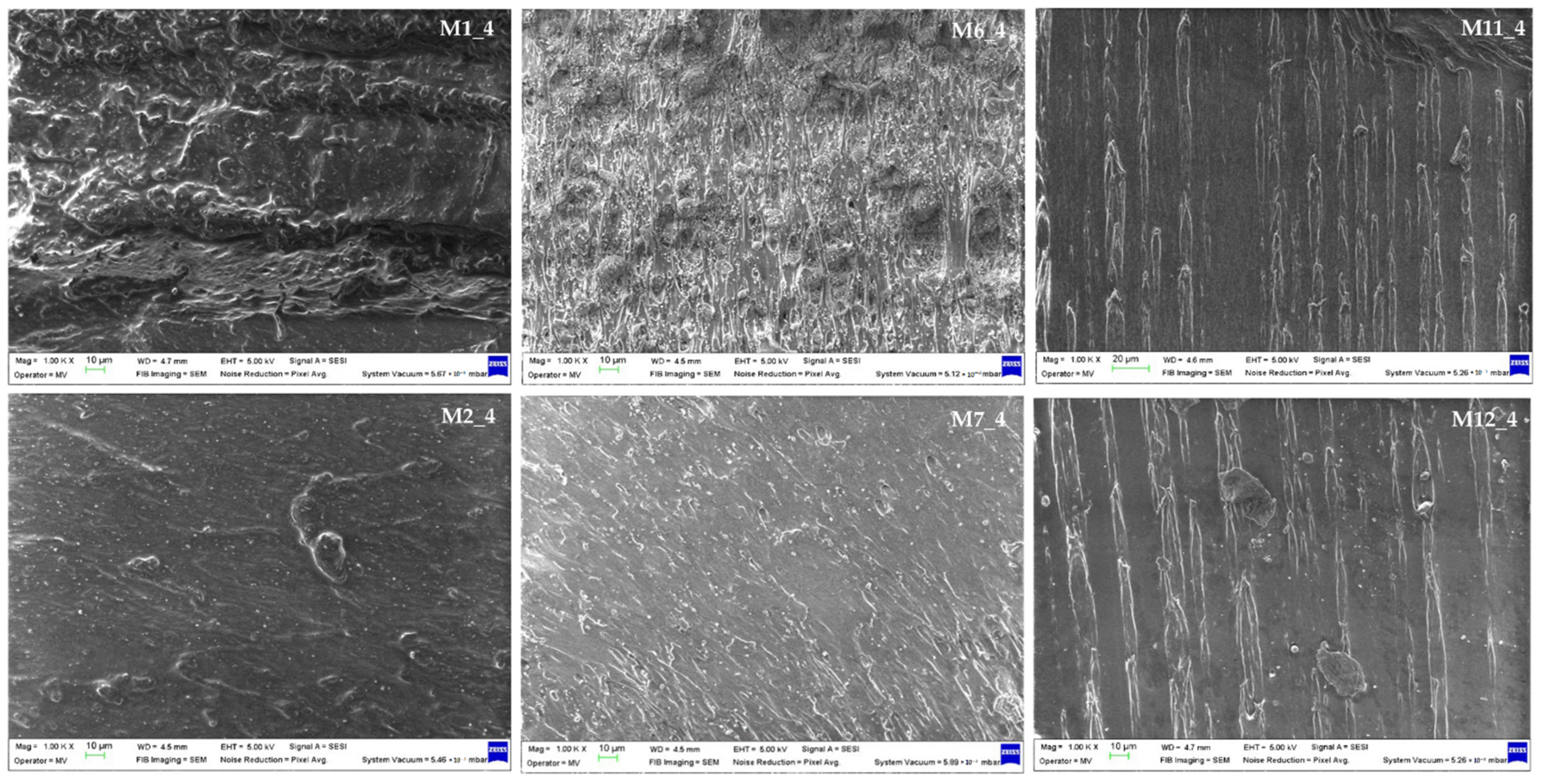
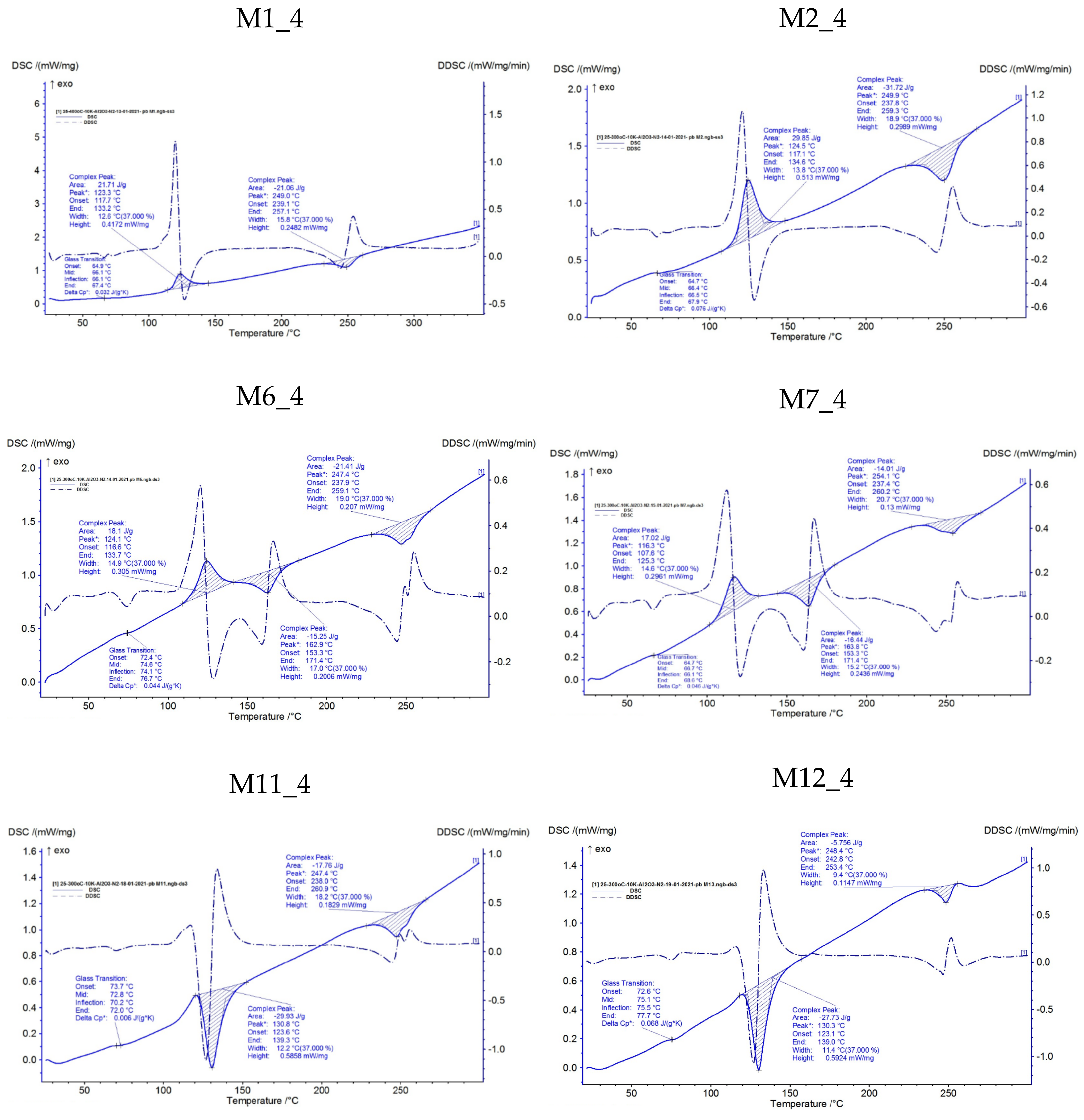

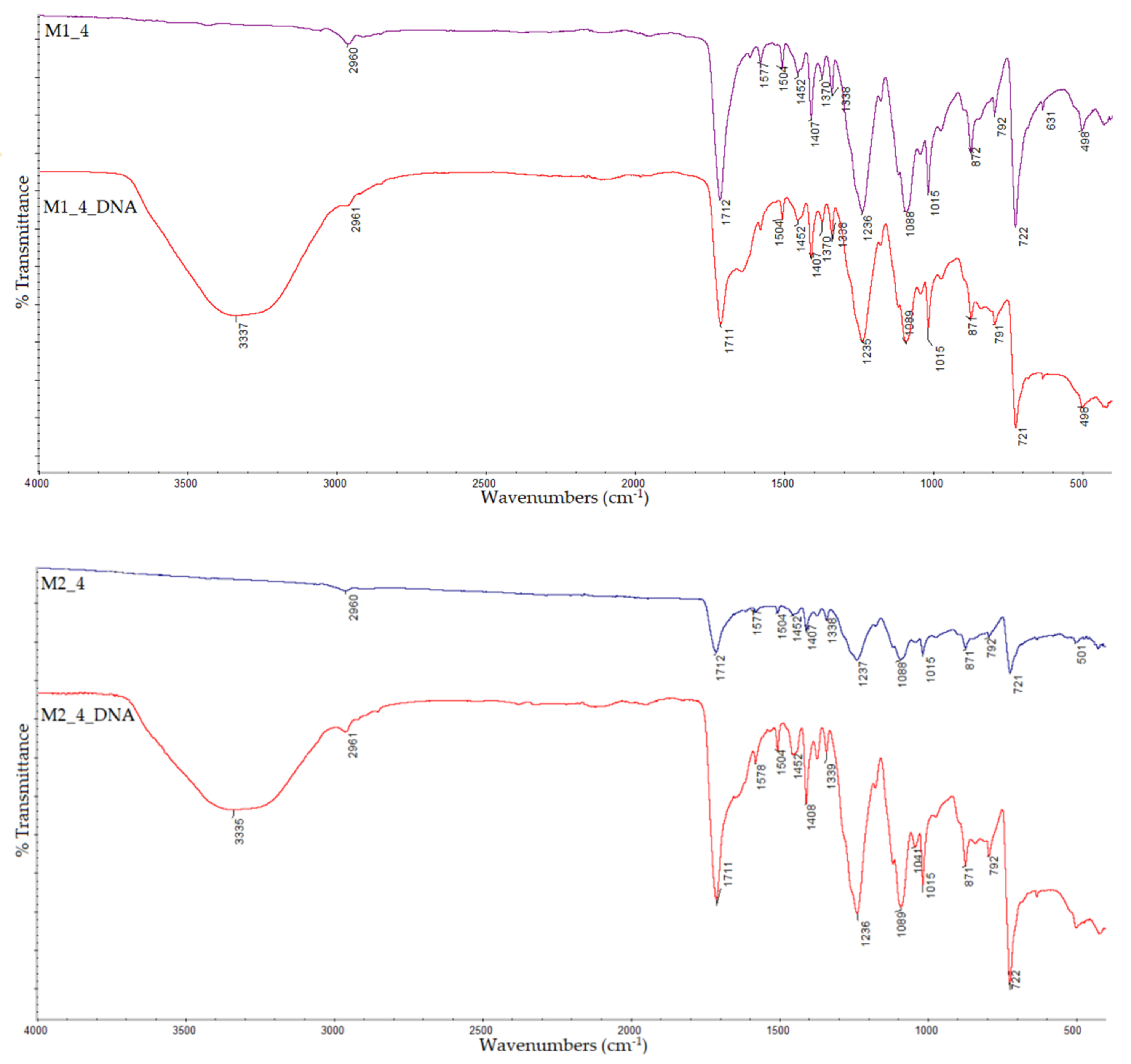
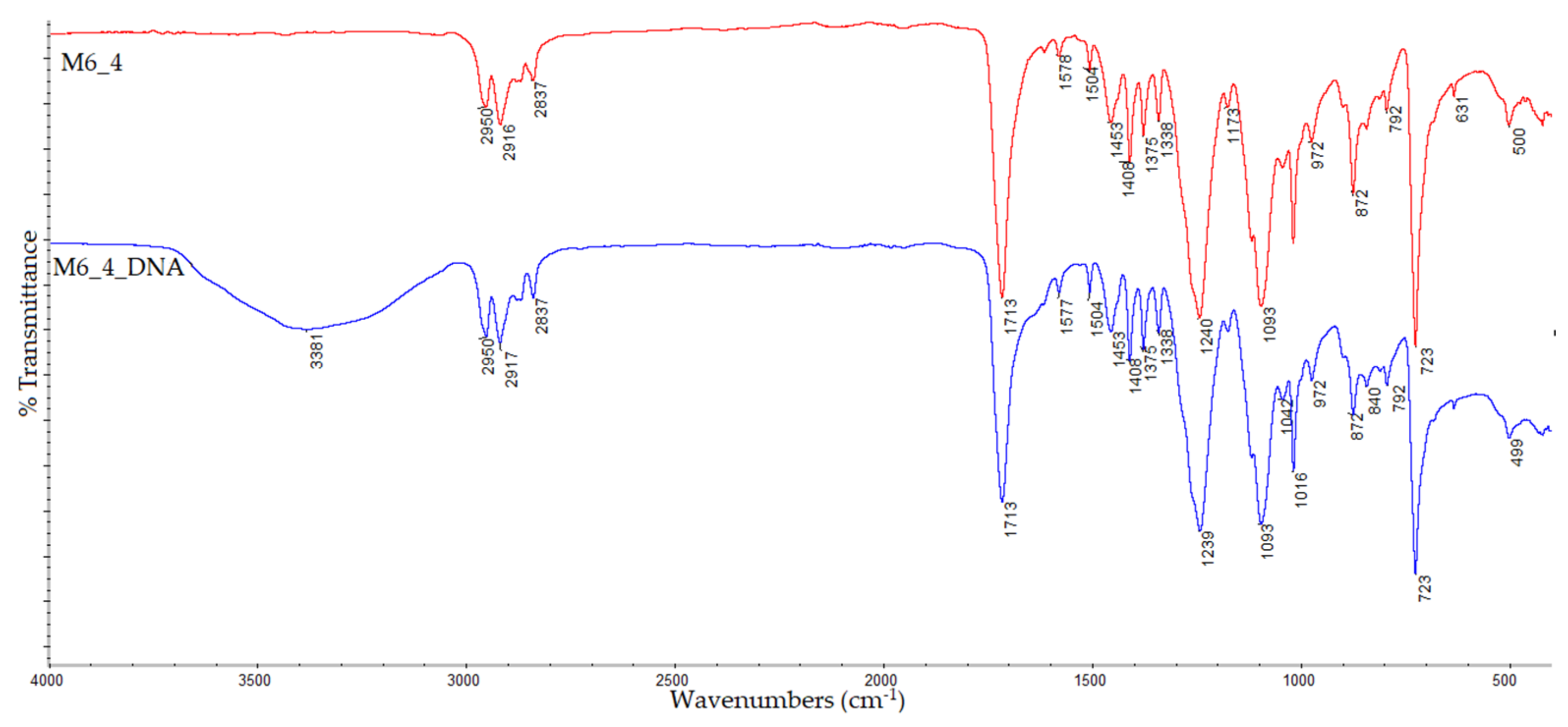

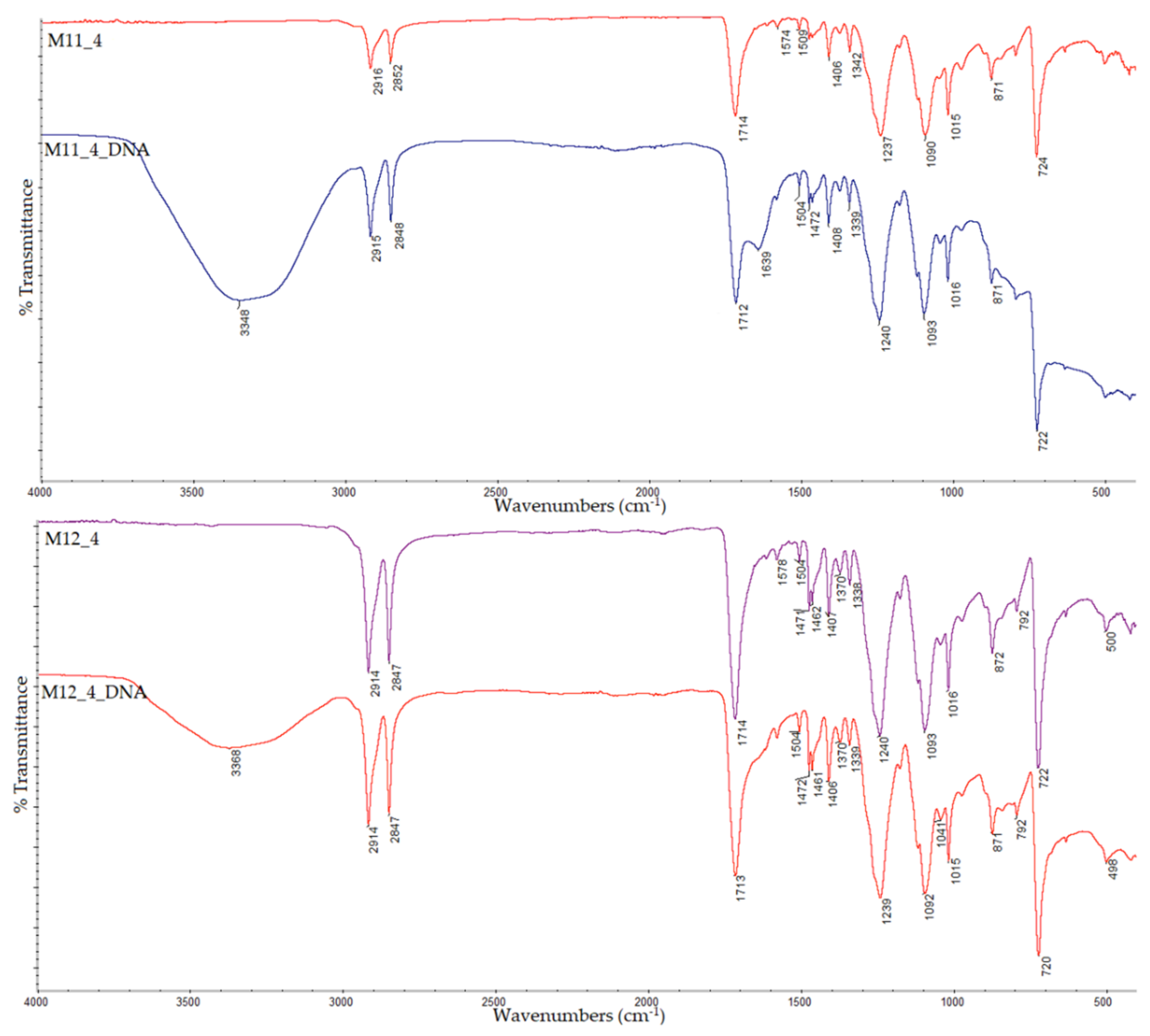

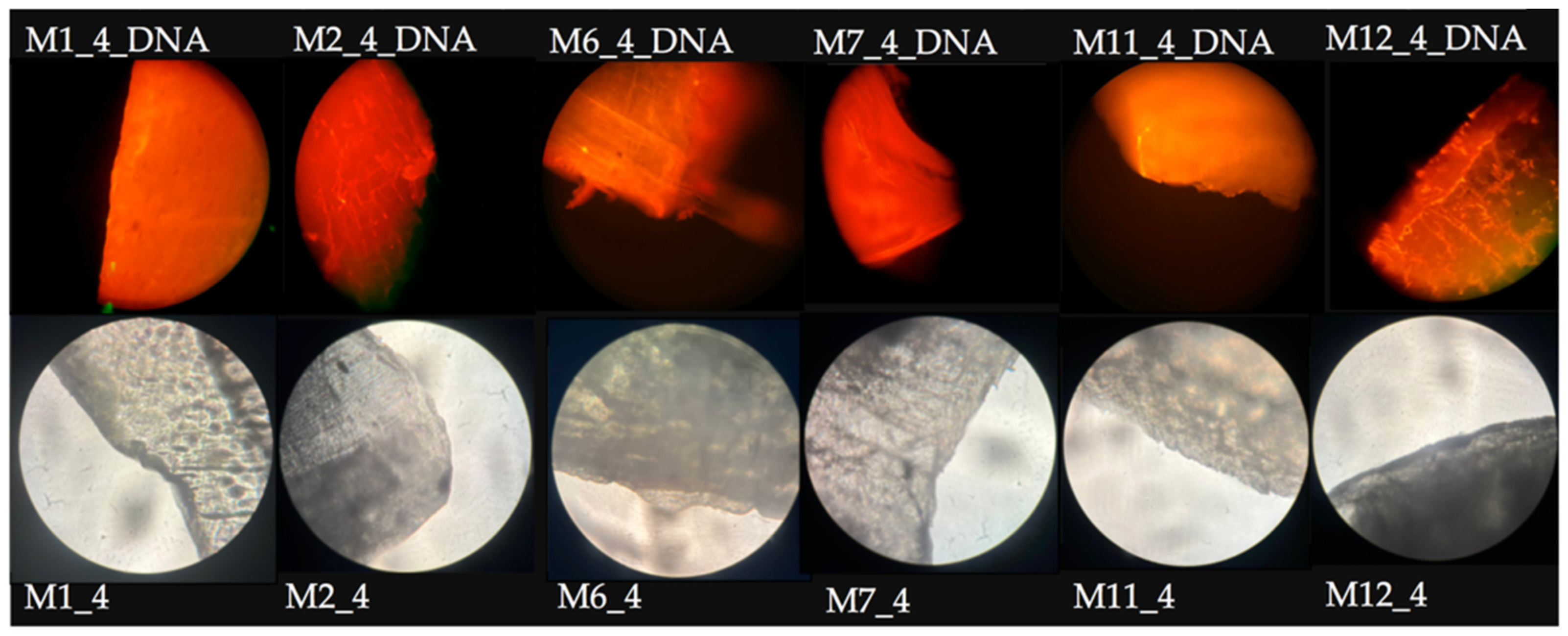
| Codification | Temperatures on Heating Zones (°C) | ||||
|---|---|---|---|---|---|
| M1_4 | 300 | 295 | 290 | 285 | 280 |
| M2_4 | 260 | 255 | 250 | 245 | 240 |
| M6_4 | 260 | 255 | 250 | 245 | 240 |
| M7_4 | 260 | 255 | 250 | 245 | 240 |
| M11_4 | 260 | 255 | 250 | 245 | 240 |
| M12_4 | 250 | 245 | 240 | 235 | 230 |
| Codification | Recycled PET (%) | PP (%) | HDPE(%) | Al Nanopowder (%) | HD (g/cm3) | Q 168 h (%) | Q 1200 h (%) |
|---|---|---|---|---|---|---|---|
| M1_4 | 100 | 0 | 0 | 0 | 1.318 ± 0.0004 | 0.22 | 0.65 |
| M2_4 | 95 | 0 | 0 | 5 | 1.347 ± 0.0009 | 0.32 | 0.68 |
| M6_4 | 70 | 30 | 0 | 0 | 1.186 ± 0.0016 | 0.24 | 1.57 |
| M7_4 | 66.5 | 28.5 | 0 | 5 | 1.395 ± 0.2833 | 0.39 | 2.07 |
| M11_4 | 70 | 0 | 30 | 0 | 1.180 ± 0.0004 | 0.25 | 1.01 |
| M12_4 | 66.6 | 0 | 28.5 | 5 | 1.210 ± 0.0000 | 0.41 | 3.80 |
| Codification | Process I | Process II | Complex Melting Process | |||||
|---|---|---|---|---|---|---|---|---|
| Glass Transition | Crystallization | Melting I | Melting I | |||||
| Tonset, °C | ∆Cp, J/g·K | Tonset, °C | Tmax, °C | Tonset, °C | Tmin, °C | Tonset, °C | Tmin, °C | |
| M1_4 | 64.9 | 0.032 | 117.7 | 123.3 | 239.1 | 249 | − | − |
| M2_4 | 64.7 | 0.076 | 117.1 | 124.5 | 237.8 | 249.9 | − | − |
| M6_4 | 72.4 | 0.044 | 116.6 | 124.1 | 153.3 | 162.9 | 237.9 | 247.4 |
| M7_4 | 64.7 | 0.046 | 107.6 | 116.3 | 153.3 | 163.8 | 237.4 | 254.1 |
| M11_4 | 73.7 | 0.006 | − | − | 123.6 | 130.8 | 238.0 | 247.4 |
| M12_4 | 74.0 | 0.045 | − | − | 123.6 | 130.4 | 238.6 | 247.0 |
Publisher’s Note: MDPI stays neutral with regard to jurisdictional claims in published maps and institutional affiliations. |
© 2022 by the authors. Licensee MDPI, Basel, Switzerland. This article is an open access article distributed under the terms and conditions of the Creative Commons Attribution (CC BY) license (https://creativecommons.org/licenses/by/4.0/).
Share and Cite
Dodi, G.; Popescu, D.; Cojocaru, F.D.; Aradoaei, M.; Ciobanu, R.C.; Mihai, C.T. Use of Fourier-Transform Infrared Spectroscopy for DNA Identification on Recycled PET Composite Substrate. Appl. Sci. 2022, 12, 4371. https://doi.org/10.3390/app12094371
Dodi G, Popescu D, Cojocaru FD, Aradoaei M, Ciobanu RC, Mihai CT. Use of Fourier-Transform Infrared Spectroscopy for DNA Identification on Recycled PET Composite Substrate. Applied Sciences. 2022; 12(9):4371. https://doi.org/10.3390/app12094371
Chicago/Turabian StyleDodi, Gianina, Diana Popescu, Florina Daniela Cojocaru, Mihaela Aradoaei, Romeo Cristian Ciobanu, and Cosmin Teodor Mihai. 2022. "Use of Fourier-Transform Infrared Spectroscopy for DNA Identification on Recycled PET Composite Substrate" Applied Sciences 12, no. 9: 4371. https://doi.org/10.3390/app12094371






